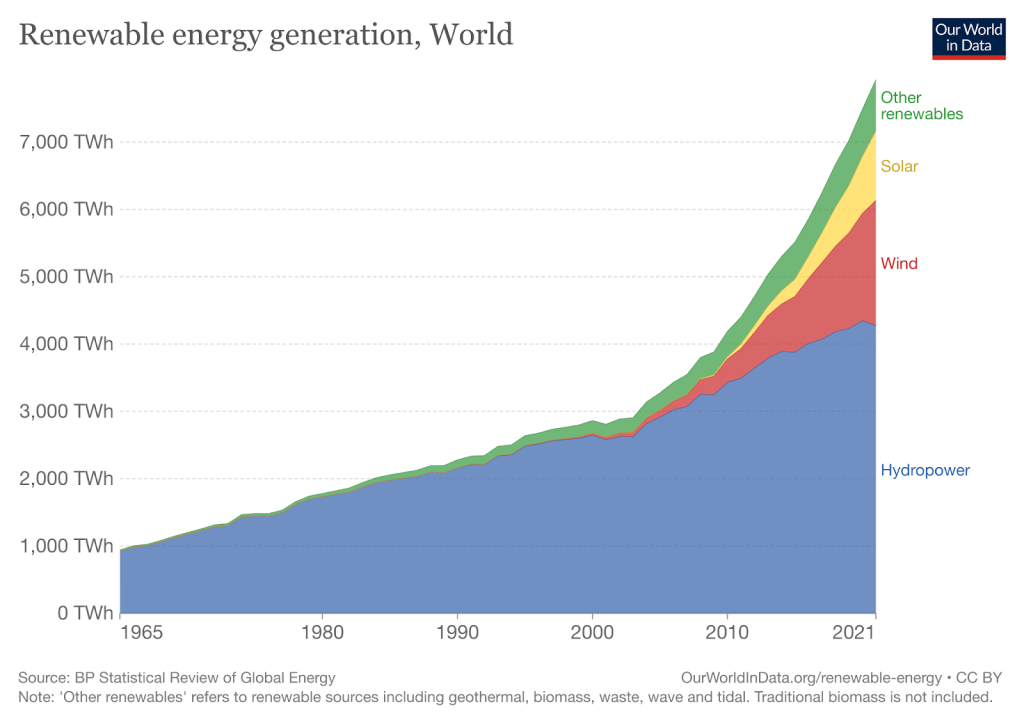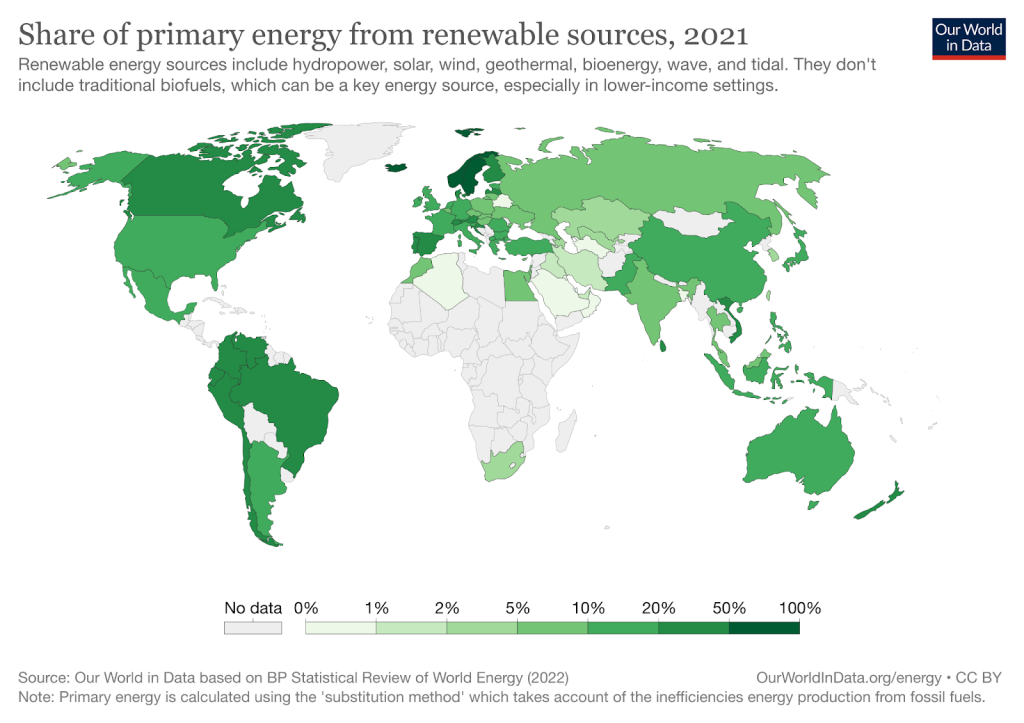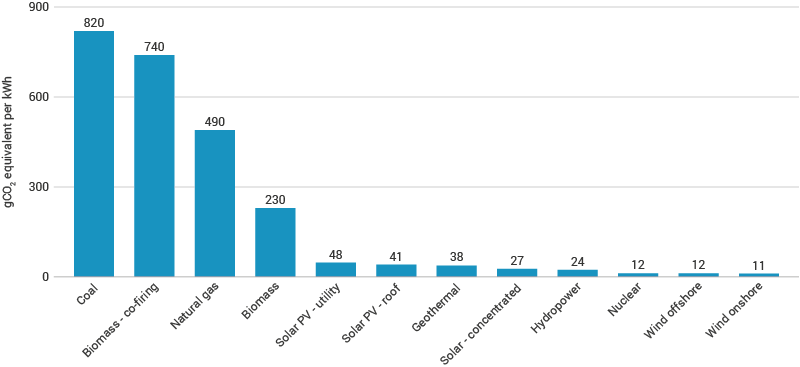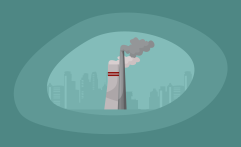Green Energy Explained: All You Need to Know
Impactful Ninja is reader-supported. When you buy through links on our site, we may earn an affiliate commission.
Learn more
Learn more
.
Hey fellow impactful ninja ? You may have noticed that Impactful Ninja is all about providing helpful information to make a positive impact on the world and society. And that we love to link back to where we found all the information for each of our posts. Most of these links are informational-based for you to check out their primary sources with one click. But some of these links are so-called "affiliate links" to products that we recommend. First and foremost, because we believe that they add value to you. For example, when we wrote a post about the environmental impact of long showers, we came across an EPA recommendation to use WaterSense showerheads. So we linked to where you can find them. Or, for many of our posts, we also link to our favorite books on that topic so that you can get a much more holistic overview than one single blog post could provide. And when there is an affiliate program for these products, we sign up for it. For example, as Amazon Associates, we earn from qualifying purchases. First, and most importantly, we still only recommend products that we believe add value for you. When you buy something through one of our affiliate links, we may earn a small commission - but at no additional costs to you. And when you buy something through a link that is not an affiliate link, we won’t receive any commission but we’ll still be happy to have helped you. When we find products that we believe add value to you and the seller has an affiliate program, we sign up for it. When you buy something through one of our affiliate links, we may earn a small commission (at no extra costs to you). And at this point in time, all money is reinvested in sharing the most helpful content with you. This includes all operating costs for running this site and the content creation itself. You may have noticed by the way Impactful Ninja is operated that money is not the driving factor behind it. It is a passion project of mine and I love to share helpful information with you to make a positive impact on the world and society. However, it's a project in that I invest a lot of time and also quite some money. Eventually, my dream is to one day turn this passion project into my full-time job and provide even more helpful information. But that's still a long time to go. Stay impactful,Affiliate Disclosure
Why do we add these product links?
What do these affiliate links mean for you?
What do these affiliate links mean for us?
What does this mean for me personally?
![]()
Green energy is a subset of renewable energy that can reduce the effects of global warming by limiting global greenhouse gas (GHG) emissions. Because it provides the highest environmental benefits in terms of carbon dioxide (CO2) emissions and protecting our environment, it is important to understand what it is and how it works. So, we had to ask: What is green energy really, and how could it help us mitigate climate change?
Green energy is the generation of energy from infinite sources that has minimal impacts on the environment. It promotes energy independence, creates jobs, produces less CO2 than traditional fossil fuels (between 4.5 and 48 gCO2 on a life-cycle basis), and mitigates climate change.
Keep reading to find out all about what green energy is, its global capacity, its carbon footprint, its environmental benefits and drawbacks, and how it can combat climate change.
The Big Picture of Green Energy
Green energy includes energy sources with a low to zero-emissions profile and carbon footprint reductions that provide the highest environmental benefits.
How Is Green Energy Defined
Green energy is a subset of renewable energy and an energy substitute for fossil fuels (e.g., coal, oil, natural gas) that can reduce the effects of global warming by limiting global GHG emissions.
“Green Energy: energy that can be produced in a way that protects the natural environment, for example by using wind, water, or the sun”
Cambridge Dictionary
Green energy is a more specific category of renewable energy that provides higher environmental benefits than renewables. It can also reduce carbon footprints, air pollution, and water environmental costs. However, green energy can also possess geographic limitations and offer intermittent production peaks depending on weather conditions.
What Are the Different Types of Green Energy
The 5 most common types of green energy are: solar, wind, hydropower (micro/low), geothermal, and wave energy.
- Solar energy is the conversion of sunlight into electrical energy either through the use of photovoltaic (PV) panels or solar radiation concentrating mirrors.
“Solar Energy: energy that uses the power of the sun to produce electricity”
Cambridge Dictionary
- Wind energy is the conversion of moving air into electrical energy. It is a form of solar energy that is caused by the uneven heating of the earth’s surface, irregularities of the earth’s surface, and the earth’s rotation.
“Wind: a current of air moving approximately horizontally, especially one strong enough to be felt”
Cambridge Dictionary
- Hydropower energy is the conversion of moving water into electrical energy through the use of various types of hydroelectric facilities. Of the three types of hydropower, only micro and low hydropower are considered green energies.
“Hydropower: hydroelectric power (= the production of electricity by the force of fast-moving water)”
Cambridge Dictionary
- Geothermal energy is the conversion of heat inside of the earth into electric energy. It is created by the decay of radioactive materials in the rock and fluid of the earth’s core.
“Geothermal: involving or produced by the heat that is inside the earth”
Cambridge Dictionary
- Wave energy is the conversion of the up and down motion of waves into electrical energy. It is created when the wind blows over the surface of the water on oceans or lakes.
“Wave Power: electrical energy generated by harnessing the up-and-down motion of ocean waves”
Britannica
These 5 types of green energy could play an important role in mitigating climate change, so let’s have a closer look at them next.
| What green energy is | Green energy is a subset of renewable energy and an energy substitute for fossil fuels (e.g. coal, oil, natural gas) |
| What the different types green energy are | The 5 most common types of green energy are: solar, wind, hydropower (micro/low), geothermal, and wave energy. |
| How green energy works | Green energy works by harvesting the kinetic energy of a specific green energy source, which turns a turbine and spins a generator to produce electricity. |
| The global capacity of green energy | Global renewable energy capacity is over 3,000 gigawatts. Only a few countries have renewables as their primary energy source, but capacity growth is expected to increase as more effort is put into reducing global GHG emissions to mitigate climate change. |
| The carbon footprint of green energy | On a life-cycle basis, the carbon footprint of green energy ranges anywhere from 4.5 to 48 grams of CO2 equivalent per kWh (gCO2/KWh) of electricity produced. |
| The environmental benefits of green energy | Green energy promotes energy independence, creates jobs, produces less CO2 than traditional fossil fuels, and mitigates climate change. |
| The environmental drawbacks of green energy | Green energy can cause land degradation, habitat loss, threats to terrestrial and aquatic wildlife, changes in water quality, and earthquakes, depending on the source. |
| Green energy and climate change | Green energy mitigates climate change because it provides the highest environmental benefits, including low to zero levels of CO2 emissions and minimal impact on the surrounding environment. |
How Does Green Energy Work
In general, green energy works by harvesting the kinetic energy of a specific green energy source which turns a turbine and spins a generator to produce electricity.
How Does Green Energy Actually Produce Energy
More specifically, each green energy source is harvested in different ways.
Solar energy uses either photovoltaic (PV) solar cells or concentrating solar thermal plants (CSP) to produce electricity. The former absorbs energy from sunlight, creating an electrical charge which moves in response to an internal electric field in the cell, causing electricity to flow. The latter reflects and concentrates sunlight onto receivers that collect and convert solar energy into heat.
- Enough sunlight strikes the surface of the earth in an hour and a half to account for the world’s energy consumption in a year. Because solar energy has such a large electricity generation potential, it is important to understand how it works.
Wind energy is generated when wind turns onshore or offshore wind turbine blades, producing electricity.
- The global installed capacity of wind energy increased by a factor of 75 between 1997 and 2018, growing from 7.5 GW to over 564 GW. Because wind energy is one of the cheapest and fastest-growing renewable energy technologies with a low carbon emissions profile, it is important to understand how it works.
Hydropower energy is generated when run-of-river, storage, pumped storage, and offshore hydroelectric facilities use flowing water to produce electricity.
- Because hydropower is one of the oldest forms of renewable energy generation and makes up more than 60% of global renewable energy generation, it is important to understand how it works.
Geothermal energy is generated when drilling down to hot water reservoirs up to a mile below the surface creates steam which is used to produce electricity.
- Because geothermal systems have a life-cycle global warming emission of approximately 0.2 pounds of CO2 equivalent per kilowatt-hour, compared to 1.4-3.6 pounds for coal, it is important to understand how it works..
Wave energy is generated when float/buoy, oscillating water columns, and tapered channel systems use the rise and fall of waves to produce electricity.
- The market for wave energy is expected to reach $141 million by 2027. Because the generating potential for wave energy is so high, it is important to understand how it works.
What Is the Global Capacity of Green Energy
All green energy is by definition also renewable energy. Renewable energy is infinite by definition because the resources naturally replace themselves over time. Green energy is in infinite supply AND has the added benefits of not producing GHG emissions or harming the environment.
Driven by decreasing costs and improved technology, renewable energy capacity grew over 4 fold from 2000-2021, increasing from 754 gigawatts (GW) to 3,064 GW. This is as more and more effort is put into reducing global GHG emissions to mitigate climate change

However, only a few countries have renewables as their primary energy source, while the vast majority of countries still have a long way to go. Approximately 11% of global primary energy came from renewable energy technologies in 2019.

What Is the Carbon Footprint of Green Energy
The carbon footprint is one of the ways we measure the effects of human-induced global climate change. It primarily focuses on the GHG emissions associated with consumption, but also includes other emissions such as methane (CH4), nitrous oxide, and chlorofluorocarbons.
“Carbon footprint: the amount of greenhouse gasses and specifically carbon dioxide emitted by something (such as a person’s activities or a product’s manufacture and transport) during a given period”
Merriam Webster
On a life-cycle basis, the carbon footprint of green energy ranges anywhere from 4.5 to 48 grams of CO2 equivalent per kWh (gCO2/KWh) of electricity produced.
| Type of Green Energy | Carbon Footprint |
| Solar | Concentrated: 38 gCO2/KWhPV roof: 41 gCO2/KWhPV utility: 48 gCO2/KWh |
| Wind | Onshore: 11 gCO2/KWhOffshore: 12 gCO2/KWh |
| Hydropower (Micro/Low) | Low: 4.5-13.6 gCO2/KWh |
| Geothermal | 38 gCO2/KWh |
| Wave | Relatively low, but more research is needed |
Have a look at the illustration below to compare the average life-cycle CO2 equivalent emissions from green energies to those of different types of energy.

When discussing the carbon footprint of certain green energy types, we must take into account carbon emissions across the energy’s building, operating, and building back phases.
| The life-cycle stages of green energy | Each stage’s carbon footprint |
| Building of green energy | Construction of green energy power plants and electricity delivery mechanisms. |
| Operating of green energy | Little to no CO2 emissions or waste products |
| Building back of green energy | CO2 emissions from decommissioning the green energy power plant and subsequent land restoration |
Because green energy provides the highest environmental benefits, it is important to understand what its carbon footprint is. And what its environmental benefits and drawbacks are.
How Environmentally Friendly Is Green Energy
The overall environmental friendliness of green energy depends on which specific type of energy is being discussed.
“Environmentally friendly: (of products) not harming the environment.”
Cambridge Dictionary
There are collective, as well as unique, benefits and drawbacks to green energy.
What Are Environmental Benefits of Green Energy
All 5 green energies have the following two benefits:
- Energy independence: Being able to produce our own electricity in the US without the aid of foreign countries is an important step to help us become more self-sufficient. Former President George W. Bush signed the Energy Independence and Security Act of 2007 to reduce US dependence on oil, expand the production of renewable fuels (and confront global climate change).
- Employment opportunities: The renewable energy sector collectively employed 12 million people worldwide in 2020. Renewable energy jobs continue to increase as we start to realize just how beneficial renewable energy is for our environment.
There are also specific benefits unique to each green energy type:
- Solar: Throughout its life cycle, concentrated solar energy produces 0.04%, PV roof solar energy produces 0.05%, and PV utility solar energy produces 0.06% of the CO2 emissions per unit of electricity that coal produces.
- Wind: Throughout its life cycle, wind energy produces 0.02% of the CO2 emissions per unit of electricity than coal produces. And after 3 to 6 months of operation, a wind turbine has effectively offset all emissions from its construction, which means it can operate virtually carbon-free for the rest of its lifetime.
- Micro/Low Hydropower: Hydropower has the potential to reduce overall GHG emissions by 5.6 gigatons by 2050, which is equivalent to nearly 1.2 billion passenger vehicles driven in a year. This would also save around $209 billion in damages caused by climate change.
- Geothermal: Throughout its life cycle, geothermal energy produces 5% of the CO2 emissions per unit of electricity that coal produces. In the US alone, annual geothermal energy resources effectively offset the emission of 4.1 million metric tons (t) of CO2, 200,000 t of SO2, 80,000 t of nitrogen oxides, and 110,000 t of particulate matter when compared to conventional coal-fired plants.
- Wave: Tidal and wave energy could help reduce global CO2 emissions from fossil fuel electricity generation by around 500 million tons by the year 2050.
What Are Environmental Drawbacks of Green Energy
Each green energy type comes with its own set of environmental drawbacks that should be taken into account when discussing its carbon footprint.
- Solar: The scale of land degradation and habitat loss depends on the technology, site topography, and intensity of the solar resource. Siting large-scale solar farms on abandoned land and small-scale farms on top of buildings or homes can minimize negative environmental impacts. Water is used for the construction of PV components, and CSPs require water for cooling. Hydrochloric acid, sulfuric acid, nitric acid, hydrogen fluoride, 1,1,1-trichloroethane, and acetone are all used to manufacture PV cells. If not handled and disposed of properly, these hazardous materials could present a serious risk to environmental and public health.
- Wind: Wind farms use a substantial amount of land, but the areas between and around turbines can be used for livestock grazing, agriculture, highways, and hiking trails. Turbine blades are large and can pose a threat to flying wildlife such as birds and bats. Extensive research and technological advances have reduced turbine-caused wildlife death. Turbines can also cause mechanical and aerodynamic noise pollution when constructed close to residential areas. Siting wind farms in remote locations or on abandoned lands can reduce this effect.
- Micro/low hydropower: Hydropower can affect aquatic organisms by interfering with fish migration, blocking movement up/downstream, and altering water flow patterns and quality conditions. Hydropower reservoirs can retain so much water that the water body below the dam dries up. Diversion projects take water away from the river and return it to the river downstream. The water released from the dam may experience changes in temperature and dissolved oxygen concentration.
- Geothermal: Geothermal reservoirs occur deep underground and are not detectable from the surface. Areas where geothermal does come to the surface are only found near tectonic plate boundaries. Also, high-pressure fluid injections close to neighboring fault lines have the potential to trigger earthquakes. 90% of all earthquakes occur in the Ring of Fire, an area that coincides with the highest concentration of geothermal resources.
- Wave: The main environmental concern with wave energy is the impact on aquatic wildlife. Construction and operation of marine energy technology may negatively impact estuarine ecosystems via underwater noise pollution, habitat changes, and wildlife collisions with turbines. Because wave energy is a relatively new technology, more research needs to be done to fully understand this environmental impact.
Why Is Green Energy Important to Fight Climate Change
Fossil fuel combustion is the main contributor to atmospheric CO2 levels. Climate Change occurs when CO2 and other air pollutants absorb sunlight and solar radiation in the atmosphere, trapping the heat and acting as an insulator for the planet. Since the Industrial Revolution, Earth’s temperature has risen a little more than 1 degree Celsius (C), or 2 degrees Fahrenheit (F). The current global annual temperature rise is 0.18C, or 0.32F, for every 10 years.
Using green energy (solar, wind, hydropower, geothermal, and wave energy) instead of fossil fuel energy helps mitigate the following negative effects of climate change:
- Increasing temperatures: Earth’s atmosphere has warmed 1.5℃ since 1880. This may not seem like a lot, but these degrees create regional and seasonal temperature extremes, reduce sea ice, intensify rainfall and drought severity, and change habitat ranges for plants and animals.
- Rising sea levels: Global sea levels have increased approximately 8-9 inches since 1880, displacing people living along coastlines and destroying coastal habitats. Roads, bridges, subways, water supplies, oil and gas wells, power plants, sewage treatment plants, and landfills remain at risk if sea level rise goes unchecked.
- Melting of sea ice: Since 1979, arctic sea ice has declined by 30%. Sea ice plays a major role in regulating the earth’s climate by reflecting sunlight into space and providing habitat for animal species. If all of the glaciers on Earth melted, sea levels would rise by approximately 70 feet, effectively flooding out every coastal city on the planet.
- Changing precipitation patterns: Extreme weather events (e.g., hurricanes, floods, droughts) are becoming more common and more intense. Storm-affected areas will experience increased precipitation and flooding whereas areas located further from storm tracks will experience decreased precipitation and droughts.
- Ocean acidification: The ocean absorbs 30% of the CO2 released into the atmosphere, which decreases the pH (increases the acidity) of the ocean. In the past 200 years, the pH of oceans has decreased by 0.1 pH units, which translates to a 30% increase in acidity. Aquatic life unable to adjust to this rapid acidification will die off. A prime example of this is coral bleaching, where coral expel the algae (zooxanthellae) living in their tissues as a result of changes in temperature, light, or nutrients.
Experts claim that to avoid a future plagued by rising sea levels, acidified oceans, loss of biodiversity, more frequent and severe weather events, and other environmental disasters brought on by the hotter temperatures, we must cut current GHG emissions by 50% by 2030 and reach net zero by 2050, as outlined in the 2015 Paris Climate Agreement. Green energy provides the highest environmental benefits, including low to zero levels of CO2 emissions and minimal impact on the surrounding environment.
The more we reduce CO2 emissions, the more we slow the rate of temperature rise, sea-level rise, ice melting, and ocean acidification. When these rates are slowed, the earth’s biodiversity does not have to struggle to adapt to temperature and pH changes. People will not be displaced due to the flooding of coastal areas. And icebergs will continue to provide climate regulation.
Final Thoughts
Since 2000 there has been a push towards green energy as a replacement for traditional fossil fuels. Harnessing the kinetic energy of green energy (solar, wind, micro/low hydropower, geothermal, and wave energy) spins a turbine and powers a generator to produce electricity. The capacity for green energy is great, but few countries currently source most of their energy from green energy.
Green energy has a lower carbon footprint than fossil fuels, combats climate change, creates jobs, and promotes energy independence, making it an environmentally friendly energy source. Any environmental concerns can all be mitigated by careful siting of power plants and proper disposal of any waste materials. Green energy benefits both our atmosphere and Earth’s biota.
Stay impactful,

Sources
- Impactful Ninja: What is the Carbon Footprint of Solar Energy?
- Impactful Ninja: What is the Carbon Footprint of Wind Energy?
- Impactful Ninja: What is the Carbon Footprint of Hydropower Energy?
- Impactful Ninja: What is the Carbon Footprint of Geothermal Energy?
- Impactful Ninja: What Is the Carbon Footprint of Tidal Energy and Wave Energy?
- Office of Energy Efficiency and Renewable Energy: How Does Solar Work?
- Office of Energy Efficiency and Renewable Energy: How Do Wind Turbines Work?
- United Nations Framework Convention on Climate Change: How Hydropower Can Help Climate Action
- Office of Energy Efficiency & Renewable Energy: Types of Hydropower
- TWI: What is Geothermal Energy? How Does it Work?
- U.S. Energy Information Administration: Hydropower Explained – Wave Power
- Kiwi Energy: Differences Between Onshore & Offshore Wind Energy
- International Renewable Energy Agency: Wind Energy
- Our World in Data: Renewable Energy
- National Renewable Energy Laboratory: Geothermal Electricity Production Basics
- Union of Concerned Scientists: Environmental Impacts of Geothermal Energy
- Union of Concerned Scientists: Environmental Impacts of Hydrokinetic Energy
- Ocean Energy Council: Wave Energy
- Allied Market Research: Wave Energy Market Size, Share Analysis – 2027
- Impactful Ninja: Renewable Energy Explained – All You Need to Know
- Impactful Ninja: Green Energy vs Renewable Energy: What’s the Difference?
- Our World in Data: Renewable Energy
- International Renewable Energy Agency: Renewable Power Generation Costs in 2021
- Our World in Data: Modern renewable energy consumption
- Our World in Data: Share of primary energy from renewable sources
- Britannica: Carbon Footprint
- World Nuclear Association: Average life-cycle CO2 equivalent emissions
- Impactful Ninja: What Is the Carbon Footprint of Green Energy?
- US Environmental Protection Agency: Summary of the Energy Independence and Security Act
- White House Archives: Fact Sheet – Energy Independence and Security Act of 2007
- International Renewable Energy Agency: Renewable Energy and Jobs – Annual Review 2021
- Wind Power Works: Wind power is crucial for combating climate change
- U.S. Department of Energy: Hydropower Vision – New Report Highlights Future Pathways for U.S. Hydropower
- National Renewable Energy Laboratory: Buried Treasure – The Environmental, Economic, and Employment Benefits of Geothermal Energy
- U.S. Government Accountability Office: Science & Tech Spotlight – Renewable Ocean Energy
- Union of Concerned Scientists: Environmental Impacts of Solar Power
- Union Of Concerned Scientists: Environmental Impacts of Wind Power
- Office of Energy Efficiency and Renewable Energy: Environmental Impacts and Siting of Wind Projects
- US Energy Information Administration: Geothermal explained – Where geothermal energy is found
- Nature: South Korea accepts geothermal plant probably caused destructive quake
- United States Geological Survey: Earthquake Glossary – Ring of Fire
- Britannica: Tidal Power
- Union of Concerned Scientists: The Hidden Costs of Fossil Fuels
- National Resources Defense Council: Global Warming 101
- The National Wildlife Federation: Climate Change
- National Oceanic and Atmospheric Administration: Climate Change – Global Temperature
- National Oceanic and Atmospheric Administration: Climate Change – Global Sea Level
- United States Geological Survey: How would sea level change if all glaciers melted?
- National Aeronautics and Space Administration, U.S.A.: How does climate change affect precipitation?
- National Oceanic and Atmospheric Administration: Ocean Acidification
- National Ocean Service: What is coral bleaching?
- United Nations Framework Convention on Climate Change: The Paris Agreement
- myclimate: What does “net zero emissions” mean?




